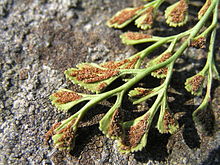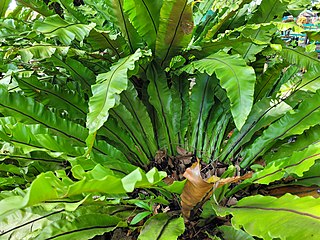
Asplenium nidus is an epiphytic species of fern in the family Aspleniaceae, native to tropical southeastern Asia, eastern Australia, Hawaii, Polynesia, Christmas Island, India, and eastern Africa. It is known by the common names bird's-nest fern or simply nest fern.
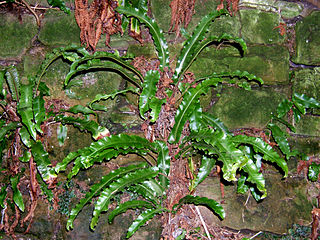
Asplenium scolopendrium, commonly known as the hart's-tongue fern, is an evergreen fern in the family Aspleniaceae native to the Northern Hemisphere.

Asplenium rhizophyllum, the (American) walking fern, is a frequently-occurring fern native to North America. It is a close relative of Asplenium ruprechtii which is found in East Asia and also goes by the common name of "walking fern".

Asplenium ruprechtii, which goes by the common name Asian walking fern, is a rare, hardy, low-lying fern native to East Asia. It is a close relative of Asplenium rhizophyllum which is found in North America and also goes by the common name of walking fern. The species should not be confused with Asplenium sibiricum which is a synonym of Diplazium sibiricum.

Asplenium ceterach, also known as the rustyback fern, is a fern species in the spleenwort family Aspleniaceae.

Asplenium septentrionale is a species of fern known by the common names northern spleenwort and forked spleenwort. It is native to Europe, Asia and western North America, where it grows on rocks. Its long, slender leaves give it a distinctive appearance. Three subspecies exist, corresponding to a tetraploid and a diploid cytotype and their triploid hybrid.

Asplenium vespertinum is a species of fern known by the common name western spleenwort. It is native to southern California and Baja California, where it grows in moist, shady, rocky places, such as the shadows beneath cliff overhangs.

Asplenium flaccidum is a species of fern in the family Aspleniaceae. The plant common name is drooping spleenwort or weeping spleenwort, and the species name flaccidum derives from the Latin root meaning drooping. An example occurrence of A. flaccidum is within a Nothofagus-Podocarp forest at Hamilton Ecological District on New Zealand's North Island in association with other fern species understory plants, crown fern, Blechnum discolor being an example.

Asplenium montanum, commonly known as the mountain spleenwort, is a small fern endemic to the eastern United States. It is found primarily in the Appalachian Mountains from Vermont to Alabama, with a few isolated populations in the Ozarks and in the Ohio Valley. It grows in small crevices in sandstone cliffs with highly acid soil, where it is usually the only vascular plant occupying that ecological niche. It can be recognized by its tufts of dark blue-green, highly divided leaves. The species was first described in 1810 by the botanist Carl Ludwig Willdenow. No subspecies have been described, although a discolored and highly dissected form was reported from the Shawangunk Mountains in 1974. Asplenium montanum is a diploid member of the "Appalachian Asplenium complex," a group of spleenwort species and hybrids which have formed by reticulate evolution. Members of the complex descended from A. montanum are among the few other vascular plants that can tolerate its typical habitat.

Asplenium antiquum is a fern of the group known as bird's-nest ferns. In Japanese it is known by ō-tani-watari and tani-watari. It grows on cliffs, in dark forests, and on tree trunks in China, Japan, Korea, and Taiwan. It is classified as an endangered species in both South Korea and Japan.

Asplenium dimorphum, the Norfolk Island spleenwort, is a species of fern in the family Aspleniaceae, endemic to Norfolk Island.

Asplenium anceps is a diploid fern of family Aspleniaceae and one of the ancestors of the ferns that form the trichomanes complex. It lives exclusively in the three northernmost archipelagoes of the Macaronesian region, that is, is an endemic macaronesian fern. Its fronds are leathery and plastic and rachis is very thick, bright reddish brown and is traversed throughout its length of three wings, two on the upper surface to draw a groove and a third on the lower surface which is characteristic and unique to this species, since all other species of the trichomanes complex without. A typical feature of this fern, which he shares with all its hybrid offspring is the existence of a small atrium on the basis of medium and less pinnae directed toward the apex of the blade with one or two sori on its underside.

Asplenium goudeyi is a fern only found on Lord Howe Island. A common plant growing in a variety of situations. On trees, or rocks, boulders, cliff faces and sometimes in exposed positions. The wavy edged fronds are 50 to 75 cm long, and 12 to 18 cm wide.

Asplenium viride is a species of fern known as the green spleenwort because of its green stipes and rachides. This feature easily distinguishes it from the very similar-looking maidenhair spleenwort, Asplenium trichomanes.

Asplenium adiantum-nigrum is a common species of fern known by the common name black spleenwort. It is found mostly in Africa, Europe, and Eurasia, but is also native to a few locales in Mexico and the United States.
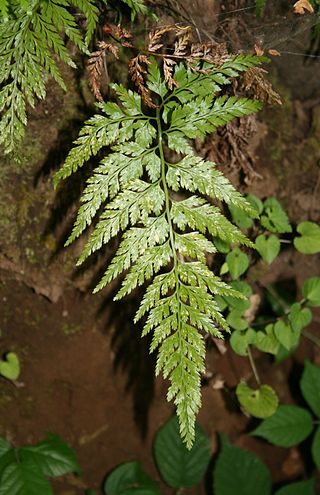
Asplenium onopteris, known as the Irish spleenwort or western black spleenwort, is a species of fern mostly found throughout the Mediterranean Basin but also around the Eastern Atlantic.

Asplenium oblongifolium is a native species of fern from New Zealand. The plant's common name is shining spleenwort and its Māori name is huruhuruwhenua. A. oblongifolium is found on the North, South, Chatham and Kermadec Islands, and is found from the coast to the mountains.

Asplenium milnei is a ground fern only found on Lord Howe Island. Commonly seen in lowland areas.
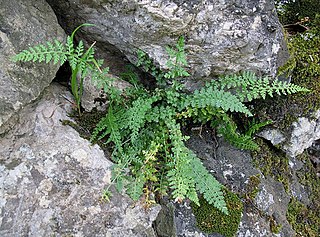
Asplenium fontanum, commonly known as fountain spleenwort or smooth rock spleenwort, is a species of fern in the family Aspleniaceae, native to rocky areas in Western Europe.
Asplenium haughtonii, also known as the Barn fern, is a species of fern in the family Aspleniaceae. It is native to Saint Helena.

